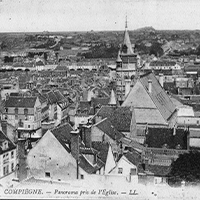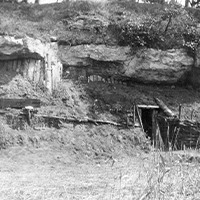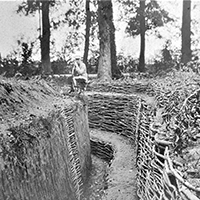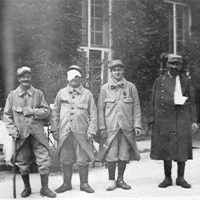Diary Excerpts
George Gilbert Smith

In 1915, urologist and 1936 AUA President George Gilbert Smith (or GG, as he was called) left his home in New England and his job at Massachusetts General Hospital to drive with his wife Ruth to New York. There he boarded a ship for France, where he was to serve for several months as a general surgeon in a clinic close to the World War I battlefront. The following diary entries and photographs from his time in France came from Dr. Smith’s grandson, Ken Rush.
Wednesday, July 21, 1915

We jogged along at about 20 miles an hour through beautiful, hilly country, and about 9:30 pm reached Springfield.
We had a very good dinner – steak, asparagus, etc. and spent the night at the Hotel Kimball. Excellent room for $5.
We slept only too well.
Saturday, July 24, 1915 | SS La Touraine French Line, Berth 144
I felt the greatest grief as we dropped out into the river and I could see Ruth, Mother, Mrs. Davey and Hester, all in black, waving handkerchiefs. For a moment I could hardly control myself. Then we started down the river and their faces became indistinguishable among the crowd.

Thursday, July 29, 1915
I would like news of Ruth and the children but must simply believe they are all right. I wish I had asked her to cable me. (GG Smith with daughters Huldah and Margaret)
[GG Smith with daughters Huldah and Margaret]
Sunday, August 1, 1915
By our daily bulletin I see that the Germans dropped a few shells into Compiégne, the town near which I am going.

Monday, August 2, 1915
At 6 p.m. we weighed anchor and started up the river Gironne…Madame Maës began to cry softly, and said, “See – la belle France is all black – the poor boys who die.” The ladies of our table said goodbye and begged me to do my best for the French soldiers.
At about 11 p.m. we reached the wharves at Bordeaux.
Thursday, August 5, 1915
Miss Turner then took me to the War Office. We talked with M. de Piessac, who said how nice of me to come over and nurse their wounded, but (in diplomatic language) who the devil was I and what right had I to claim to be a surgeon? He said it would take at least 2 days for him to find out these things, so here I am, stuck for 2 days more.
Friday, August 6, 1915
This morning I took a taxi for the American Ambulance Hosp at Neuilly…I met Drs. Hutchinson, Keating and others of Phila. and made the visit with them. Dr. Hutchinson has 195 beds. Most of the cases are bone injuries – great gaping comminuted fractures from shrapnel, or through and through perforations. I learned a lot about their method of treatment. The cases come to them often after they have been in several other hospitals, and never with fresh injuries. The hospital is very well equipped, and quite attractive.

Friday, August 6, 1915
Had my pictures taken at M. Felix, 6 Boul. des Italiens. 4 exposures; he will send me 3 proofs. I get 2 finished pictures for 35 fr. Others cost 5 fr. apiece. A good deal to spend on my likeness, but it will please the people at home, I hope.
Saturday, August 7, 1915
They say the reason for this delay is that there have been spies among the American doctors, and one was shot at Verdun. Cheerful thought!...Germans have taken Warsaw.
Tuesday, August 10, 1915

Compiégne (which was bombarded a few days ago) is split by the River Oise. Our road runs along the left bank of the river. Beyond a stretch of flat country, rather heavily wooded, lying across the river, is a range of hills, perhaps 4 miles away. These are held by the Germans.
…It seems so beautiful here that one can’t believe the front is only a few miles distant, although occasionally one hears a distant gun.
Thursday, August 12, 1915

This morning I did dressings in the wards. It is true that all the wounds go septic to some extent, but the inflammation does not as a rule involve the surrounding tissues. The keynote seems to be to disinfect with strong solutions (Carrel’s #30 = hyposulphite of soda, boric acid, & other ingredients which I don’t know) and to drain, but not much by counter openings or free incisions; chiefly through the wounds themselves.
We crossed the Oise over a pontoon bridge built to replace the stone bridge blown up by the English in their retreat. We saw a house which had been struck by one of the heavy German shells – it was merely a heap of debris.

Sunday, August 22, 1915
Beautiful day. Dressings in a.m. as usual. After lunch walked over the hill with Mrs. Depew and Miss. Turner. We saw the embrasures or observation posts dug out of the hillside. They would have made great caves for boys to play in.
Wednesday, August 25, 1915
About 10:30 an aeroplane buzzed over. It was a fine moonlit night, but he was invisible. Another came, and another, or perhaps the first returned. At any rate they kept going over the chateau until 2:30 a.m. Everyone got up about 1 a.m. An explosion sounded, almost as if it were on the lawn. We were sure the aviator was trying to get us. It was an uncomfortable feeling to be in the house with no method of retaliation. We could hear the aeroplane approaching – buzz –z –z like a big mosquito. We waited for a crash as he flew over. But nothing happened and we think this last one was French, as some of the men thought they could see his two propellers.
In the morning we learned that the explosion we heard was indeed that of a bomb, dropped by the Germans at the foot of our lawn, perhaps ¼ mile away. Probably he was after the new trenches being built there. The soldiers on guard took a few shots at him with a rifle which we could hear.

Monday, August 30, 1915
…On the way back, I met the Chief of the civilians who are making trenches, and he showed me how well they were made, with wattled sides. The woods in places are netted with them.
Thursday, September 2, 1915
While we were doing dressings this a.m. an officer came and told Stanley to evacuate everyone who could be removed with safety. So we cleared out, and made a list of 27 – all except 4. Evidently the French intend an attack. We have also heard that all men on leave are recalled, and Stanley who was going on Saturday for a vacation has been asked to wait.
Friday, October 8, 1915

Before lunch a man who was whittling a cartridge came in with end of thumb and forefinger blown off. Fixed him up after lunch.
Then 11 (!) new patients came in the ambulances – none very seriously wounded – and I was busy all p.m. and evening fixing them. A great day.
Saturday, October 9, 1915
A.M. – did dressings, took X Rays and set a Colles fracture…After lunch, did a hernia with appendectomy, a large hydrocele, & took a piece of bomb out of a man’s hand. Quite a long day.

Saturday, October 16, 1915
The cpd. fracture of thigh is running a temp and his thigh is a little reddened. After luncheon I opened it and found the vastus externus full of thin purulent fluid. Moral: cut whenever in doubt as to the presence of pus. Early & thorough drainage. His temp fell to normal after that.
Wednesday, October 20, 1915
A busy morning. Mrs. D wants me to stay another week, and as Stanley isn’t coming back until Saturday, I’ll have to. However, I’m over busy and the work is all mine.
About 4 p.m. a man shot in many places by shrapnel came in. His lumbar spinous processes were shot away, with possible involvement of the peritoneum. He was in much shock. I anesthetized him, cleaned him up quickly, put in Carrel’s drip. Four other minor cases came in. 45 patients tonight.
Thursday, October 21, 1915
Called at 4 a.m. because of spine man. Thought he had peritonitis and was getting ready to operate when he died. Autopsy showed that one ball had passed through right kidney, tearing away pelvis. Not much hemorrhage. No peritonitis.
Monday, October 25, 1915
Was wakened at about 5 a.m. by night nurse who said that the fract. femur man had a slight hemorrhage. Got up and saw him, and thought amputation the only sure way. Called Stanley; did a transfusion (Vincent’s Tubes) putting about 1300 cc blood into him.
It worked like a charm.
Then I gave him spinal, and Stanley amputated at mid thigh. He did very well. Many of the men wanted to be donors – quite different from in a civil hospital.
Tuesday, October 26, 1915 | Return to America

I left about 5:20. It was dusk, and as I stepped out into the courtyard to get into the car, I saw a regular army lined up in front of the fountain.
The center was composed of nurses, led by Mrs. Depew; the right wing, of convalescents, the left, of orderlies. They were clapping and cheering feebly. Mrs. Depew cried, “Speech.” I went to them and said “What can I say except that I hate to leave you?”
Thursday, October 28, 1915 | Paris
At 4 p.m. I presented Mrs. Depew’s card to Prof. Pozzi, 47 Ave. d’Jena. He was in a uniform of dark blue, most becoming, and was delightful. We talked for a few minutes, chiefly about Dr. Dunn, and he invited me to meet him tomorrow at this hospital.
Friday, October 29, 1915

Went to the hospital at the Parthenon (or near it) to see Dr. Pozzi. It is a hosp. of 1000 beds, pretty crude in its appearance. The nurses wear funny black bonnets with little tricolor cockades. Prof. Pozzi was very nice, & showed me cases, among them a German officer shot thru the shoulder. He then took me to the Hosp Broca where he had military & some gyn. cases.
He ligated an aneurysm of the femoral artery.
He is very genial and has a rather attractive, familiar way. He gave me his picture, and was altogether very kind.
[Fascinating Fact: In 1918, former patient Maurice Machu approached Pozzi in his consulting room. Pozzi had operated on him for varicocele of the scrotum, and Machu believed he had become impotent as a result. Machu asked Pozzi to operate again. When Pozzi refused because he could not remedy the situation, Machu shot him four times in the stomach. Pozzi ordered himself taken to the Astoria Hospital - converted into a military hospital for wounded from WW I - but the emergency laparotomy was unsuccessful and he died shortly afterwards. Machu later committed suicide. Wikipedia]

Saturday, October 30, 1915
Took the 8:40 a.m. Express – Paris to Bordeaux.
The Lafayette is a very fine boat. This is her maiden trip.
Monday, November 8, 1915
Sighted Nantucket light ship at 10 a.m. & Fire Island at 5:30
Beautiful calm sunset.

Diary entries and photographs courtesy of Ken Rush, son of Dr. Smith’s youngest daughter Jane. Smith’s eldest daughter, Margaret, was a bit of an adventurer...It is said that she climbed cathedral ledge in the White Mountains in the 1930s and may have been one of the first women to do so. In her younger years she was a great backwoods skier in the Rockies. During the 60s, she would race her Porsche, and she sometimes piloted small planes.
Middle daughter Huldah became chief curator of the Essex Institute in Salem and wrote the “Museum Collections of the Essex Institute.” Jane Gilbert Smith married Kenneth Rush, supporting his career as Ambassador to West Germany and France and raising four children.
















